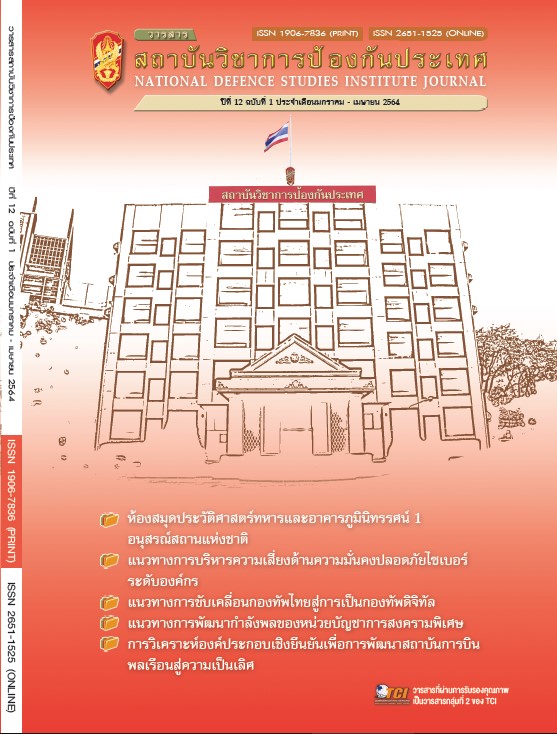A Confirmatory Factor Analysis for High Performance Organization Development Civil Aviation Training Center (CATC)
Main Article Content
Abstract
Objective: This study aims to study factors corresponding to operating procedures towards an excellent management of the Civil Aviation Training Center (CATC) and to examine compositions that lead to the excellence of CATC.
Method: This study is an empirical study by randomly selecting 445 samples. The samples consist of executives, acting executives, deputy director, division chief, chief, aviation instructors, all staffs of CATC, current students both from Ground Training Program and Aerial Training Program, and the alumni of CATC in the last 15 years. The samples were selected from 19,697 persons. Research tools consist of Confirmatory Factor Analysis questionnaire with 57 items and a LISREL software to analyze the data.
Results: There are six major components to achieve excellence of the CATC: 1) CATC direction, 2) educational personnel, 3) educational management, 4) factors and atmosphere that affect learning quality, 5) the institution’s management system, and 6) leadership (6 variables observed). The results from the analysis of the conformity between the confirmatory factor model of the CATC development towards excellence and the empirical data indicate the degree of statistical fit index as follows: Chi-Square (χ2) = 708.28, df = 676, p-value = 0.189, RMSEA = 0.010, SRMR = 0.028, CFI = 1.00, GFI = 0.94. The results from the analysis of Composite Reliability (CR) and the Average Variance Extracted (AVE) show that CR of latent variables has a maximum value of 0.98 and a minimum value of 0.95. It indicates that each latent variable is able to explain the variance of the observable variables in a unified manner. From the evaluation of the model, it is found that all latent variables are accurate and reliable, which shows that there is a conformity between the confirmatory factor model of the CATC development towards excellence and the empirical data. Therefore, it has the potential to apply and conform to the research theoretical concept.
Article Details

This work is licensed under a Creative Commons Attribution-NonCommercial-NoDerivatives 4.0 International License.
The articles, images, tables, graphs, written content, and opinions published in this journal are solely those of the authors and do not necessarily reflect the views or positions of the National Defence Studies Institute or its academic affiliates.
References
ลดาวรรณ บุญล้อม. (2553). ลักษณะขององค์การแห่งความเป็นเลิศ. สารนิพนธ์วิทยาศาสตรมหาบัณฑิต (การพัฒนาทรัพยากรมนุษย์และองค์การ). คณะพัฒนาทรัพยากรมนุษย์ สถาบันบัณฑิตพัฒนบริหารศาสตร์. กรุงเทพฯ.
สำนักงานคณะกรรมการนโยบายรัฐวิสาหกิจ. (ม.ป.ป.). คู่มือระบบประเมินผลการดำเนินงานรัฐวิสาหกิจ. กรุงเทพฯ:กระทรวงการคลัง.
สำนักงานคณะกรรมการพัฒนาระบบราชการ. (2557). เกณฑ์คุณภาพการบริหารจัดการภาครัฐ พ.ศ.2558. กรุงเทพฯ:บริษัท วิชั่น พริ้นท์ แอนด์ มีเดีย จำกัด.
De Waal, A. (2012). Characteristicsofhigh performance organisations. Journal of Management Research,4 (4), 39-71.
De Waal, A., Peters, L., and Broekhuizen, M. (2017). Do different generations look differently at high performance organizations?. Journal of Strategy and Management, 10(1), 86-101.
George, D., and Mallery, P. (2010). SPSS for Windows step by step: A simple guide and reference,17.0 update (10th ed.). Boston: Pearson.
Hair et al., (2014). Multivariate data analysis (6th ed.). NJ: Pearson Education International.
Kline,R.B. (2005). Principles and practice of structural equation modeling (2nd ed.). New York: Guilford.
Van Assen, M. F., Van den Berg, G., and Pietersma, P. (2009).Key management models: The 60+ models every manager needs to know (2nd ed.). Harlow, UK: Prentice Hall, Financial Times.
Yadav, N., and DeWaal, A. (2020). Comparison of Indian with Asian organizations using the high performance organization framework: An empirical approach. Journal of Transnational Management, 25(3). Retrieved from https://www.tandfonline.com/doi/abs/10.1080/15475778.2020.1770016?journal Code=wtnm20


